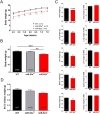Phenotypic characterization of miR-92a-/- mice reveals an important function of miR-92a in skeletal development
- PMID: 24979655
- PMCID: PMC4076267
- DOI: 10.1371/journal.pone.0101153
Phenotypic characterization of miR-92a-/- mice reveals an important function of miR-92a in skeletal development
Abstract
MicroRNAs (miRNAs, miRs) emerged as key regulators of gene expression. Germline hemizygous deletion of the gene that encodes the miR-17∼92 miRNA cluster was associated with microcephaly, short stature and digital abnormalities in humans. Mice deficient for the miR-17∼92 cluster phenocopy several features such as growth and skeletal development defects and exhibit impaired B cell development. However, the individual contribution of miR-17∼92 cluster members to this phenotype is unknown. Here we show that germline deletion of miR-92a in mice is not affecting heart development and does not reduce circulating or bone marrow-derived hematopoietic cells, but induces skeletal defects. MiR-92a-/- mice are born at a reduced Mendelian ratio, but surviving mice are viable and fertile. However, body weight of miR-92a-/- mice was reduced during embryonic and postnatal development and adulthood. A significantly reduced body and skull length was observed in miR-92a-/- mice compared to wild type littermates. µCT analysis revealed that the length of the 5th mesophalanx to 5th metacarpal bone of the forelimbs was significantly reduced, but bones of the hindlimbs were not altered. Bone density was not affected. These findings demonstrate that deletion of miR-92a is sufficient to induce a developmental skeletal defect.
Conflict of interest statement
Figures




Similar articles
-
Germline deletion of the miR-17∼92 cluster causes skeletal and growth defects in humans.Nat Genet. 2011 Sep 4;43(10):1026-30. doi: 10.1038/ng.915. Nat Genet. 2011. PMID: 21892160 Free PMC article.
-
The miR-17-92 cluster expands multipotent hematopoietic progenitors whereas imbalanced expression of its individual oncogenic miRNAs promotes leukemia in mice.Blood. 2012 May 10;119(19):4486-98. doi: 10.1182/blood-2011-09-378687. Epub 2012 Mar 26. Blood. 2012. PMID: 22451425
-
Analysis of Cell Type-Specific Effects of MicroRNA-92a Provides Novel Insights Into Target Regulation and Mechanism of Action.Circulation. 2018 Nov 27;138(22):2545-2558. doi: 10.1161/CIRCULATIONAHA.118.034598. Circulation. 2018. PMID: 30571345
-
miR-92a family and their target genes in tumorigenesis and metastasis.Exp Cell Res. 2014 Apr 15;323(1):1-6. doi: 10.1016/j.yexcr.2013.12.025. Epub 2014 Jan 4. Exp Cell Res. 2014. PMID: 24394541 Review.
-
The Role of miRNAs, miRNA Clusters, and isomiRs in Development of Cancer Stem Cell Populations in Colorectal Cancer.Int J Mol Sci. 2021 Jan 31;22(3):1424. doi: 10.3390/ijms22031424. Int J Mol Sci. 2021. PMID: 33572600 Free PMC article. Review.
Cited by
-
Osteoclast-derived microRNA-containing exosomes selectively inhibit osteoblast activity.Cell Discov. 2016 May 31;2:16015. doi: 10.1038/celldisc.2016.15. eCollection 2016. Cell Discov. 2016. PMID: 27462462 Free PMC article.
-
Conditional disruption of miR17-92 cluster in collagen type I-producing osteoblasts results in reduced periosteal bone formation and bone anabolic response to exercise.Physiol Genomics. 2015 Feb;47(2):33-43. doi: 10.1152/physiolgenomics.00107.2014. Epub 2014 Dec 9. Physiol Genomics. 2015. PMID: 25492928 Free PMC article.
-
Evaluation of microRNA 92a Expression and Its Target Protein Bim in Colorectal Cancer.Asian Pac J Cancer Prev. 2022 Feb 1;23(2):723-730. doi: 10.31557/APJCP.2022.23.2.723. Asian Pac J Cancer Prev. 2022. PMID: 35225486 Free PMC article.
-
Small RNA expression and miRNA modification dynamics in human oocytes and early embryos.Genome Res. 2021 Aug;31(8):1474-1485. doi: 10.1101/gr.268193.120. Genome Res. 2021. PMID: 34340992 Free PMC article.
-
The emerging role of non-coding RNA in essential hypertension and blood pressure regulation.J Hum Hypertens. 2015 Aug;29(8):459-67. doi: 10.1038/jhh.2014.99. Epub 2014 Nov 13. J Hum Hypertens. 2015. PMID: 25391760 Review.
References
Publication types
MeSH terms
Substances
Grants and funding
LinkOut - more resources
Full Text Sources
Other Literature Sources
Molecular Biology Databases
Research Materials

